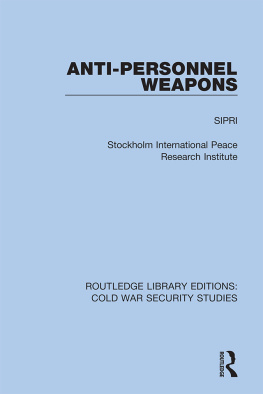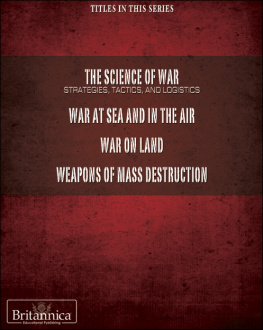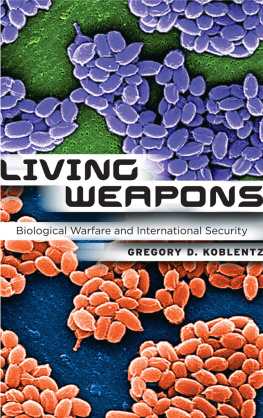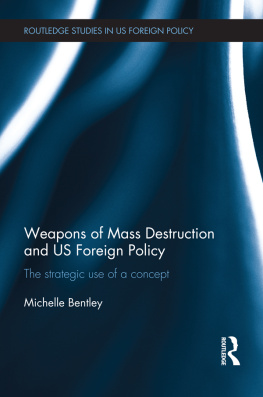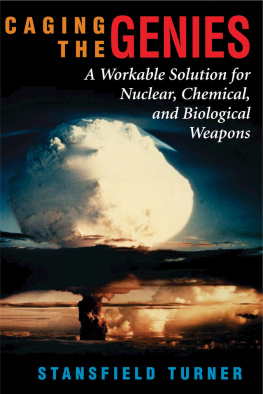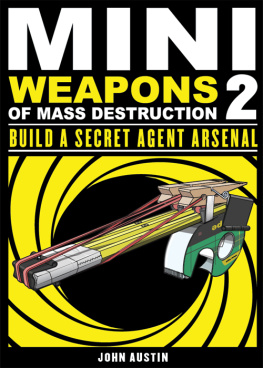ROUTLEDGE LIBRARY EDITIONS:
INTERNATIONAL SECURITY STUDIES
Volume 23
WEAPONS OF MASS DESTRUCTION
AND THE ENVIRONMENT
WEAPONS OF MASS DESTRUCTION
AND THE ENVIRONMENT
SIPRI
STOCKHOLM INTERNATIONAL PEACE
RESEARCH INSTITUTE
First published in 1977 by Taylor & Francis Ltd., London
This edition first published in 2021
by Routledge
2 Park Square, Milton Park, Abingdon, Oxon OX14 4RN
and by Routledge
52 Vanderbilt Avenue, New York, NY 10017
Routledge is an imprint of the Taylor & Francis Group, an informa business
1977 SIPRI
All rights reserved. No part of this book may be reprinted or reproduced or utilised in any form or by any electronic, mechanical, or other means, now known or hereafter invented, including photocopying and recording, or in any information storage or retrieval system, without permission in writing from the publishers.
Trademark notice: Product or corporate names may be trademarks or registered trademarks, and are used only for identification and explanation without intent to infringe.
British Library Cataloguing in Publication Data
A catalogue record for this book is available from the British Library
ISBN: 978-0-367-68499-0 (Set)
ISBN: 978-1-00-316169-1 (Set) (ebk)
ISBN: 978-0-367-71624-0 (Volume 23) (hbk)
ISBN: 978-0-367-71630-1 (Volume 23) (pbk)
ISBN: 978-1-00-315297-2 (Volume 23) (ebk)
Publishers Note
The publisher has gone to great lengths to ensure the quality of this reprint but points out that some imperfections in the original copies may be apparent.
Disclaimer
The publisher has made every effort to trace copyright holders and would welcome correspondence from those they have been unable to trace.
Weapons of
Mass Destruction
and the Environment
sipri
Stockholm International Peace Research Institute
First published 1977 by Taylor & Francis Ltd., London and Crane, Russak & Company, Inc., New York
Copyright 1977 by SIPRI
Sveavgen 166, S-113 46 Stockholm
All rights reserved. No part of this publication may be reproduced, stored in a retrieval system or transmitted, in any form or by any means, electronic, mechanical, photocopying, recording or otherwise, without the prior permission of the copyright owner.
ISBN 0 8448 1295 1
Library of Congress Catalog Card Number 77-15308
Printed and bound in the United Kingdom by Taylor & Francis (Printers) Ltd, Rankine Road, Basingstoke, Hampshire RG24 OPR
Given the present state of the world, it is essential to the future well-being of mankind that nuclear, chemical, biological and other weapons of mass destruction be eliminated from the arsenals of the world. A substantial fraction of the research effort of SIPRI has been devoted to providing objective information that would help to create an appropriate climate for relevant disarmament efforts and that would also prove useful to the negotiators themselves.
The present book is the product of one of the several recent and current SIPRI projects devoted to the environmental aspects of arms control and disarmament, a hitherto neglected area of concern in this context. A partial listing of related SIPRI publications will be found on page 88. It is hoped that these documents will contribute to the success of the special session on disarmament of the UN General Assembly scheduled for MayJune 1978.
This book was written by Dr Arthur H. Westing, a senior research fellow at SIPRI. He is on leave from Windham College in Putney, Vermont, where he is professor of botany.
July 1977
Frank Barnaby
Director
Superior numerals, thus.
Nuclear weapons exist, they have been employed and they can have a tremendous ecological impact. No treatment of the interaction between weapons of mass destruction and the environment would be complete without an examination of nuclear weapons.
Nuclear weapons come in all sizes or yieldsGlasstone, 1964: 681 a), one gathers that likely sizes for use as strategic nuclear weapons would be in the range of 1 Mt to 10 Mt. Hundreds if not thousands of such weapons might be expended within a period of days during some major nuclear exchange of the future. By way of partial contrast, the total energy yield of all the munitions expended during 812 years of the Second ).
Nuclear weapons are awe-inspiring not only for their total energy yield, but also for the several forms in which this energy is dissipated, as will be seen in the following section. The ecological consequences of nuclear war are covered in section III of this chapter.
The effects of a nuclear attack depend not only upon the number of devices detonated and their types and sizes, but also upon how they are distributed in time and space. The effects are strongly influenced by whether a burst occurs at or near ground level, substantially below ground, under water, in the denser portions of the atmosphere (that is, below about 30 km), or even in the very rarified upper atmosphere. The character of the terrain, weather conditions and other factors also modify the character and magnitude of the effects.
A nuclear bomb that bursts in the troposphere high enough that its fire-ball does not reach the ground). Another third of the energy will be released in the form of thermal radiation. The remaining energy will be expended in the form of nuclear radiation, about one third of this within the initial minute and the rest over a much longer period of time.
Table 1.1. Distribution of energy release by a nuclear bomb exploded in the troposphere
Energy released |
Energy form | (1012 J) | (1015 J) | (1015 J) |
Bomb size: | 18 kt | 0.91 Mt | 9.1 Mt |
Blast (shock) | 41.9 | 2.28 | 22.8 |
Thermal radiation | 29.3 | 1.59 | 15.9 |
Nuclear radiation, first min | 4.2 | 0.10 | 1.0 |
Nuclear radiation, residual | 8.4 | 0.21 | 2.1 |
Total | 83.7 | 4.19 | 41.9 |
Notes:
(a) For an explanation of bomb size designations, see note 2.
(b) The data are derived from those of Glasstone (1964: 7-9).
(c) The 18 kt bomb is a fission bomb, whereas the 0.91 Mt and 9.1 Mt bombs are half fission and half fusion. The explosions are so-called typical air bursts. Comparable data for surface bursts are difficult to generalize about.
A burst in the very thin air above the stratosphere will translate significantly less of its energy into blast and more into thermal radiation. Surface and sub-surface bursts, either terrestrial or aquatic, produce far more radioactive fall-out than do air bursts. Underwater bursts are a class by themselves. Their effects differ markedly depending upon how far below the surface the bomb is detonated, how deep and how large the body of water is and other factors. The reader is referred to Glasstone (1964: VI) for further information on underwater nuclear explosions.



